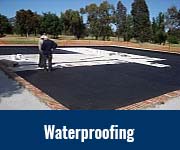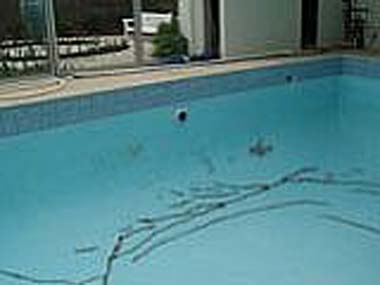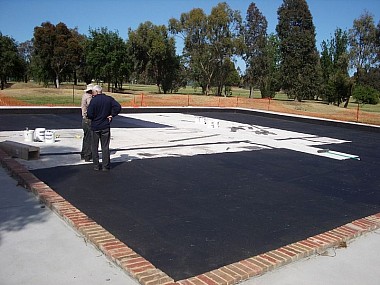Similar principles apply to new construction and repair of Pools and Ponds. Scale and complexity vary by job, but the ‘shell’ must be secure and sound, if in-ground, is ground water pressure likely to be a problem, and finally determine the capabilities of the desired finish to waterproof. The following information is designed for practical advice in three situations:
WATERPROOFING
Pool constructions usually start with concrete spray over metal reinforcing, which is the vital phase of securing the structure. Adding a crystalline compound to the mix on site can provide waterproofing insurance. Depending on the job, adding vapour barrier to the inside surface problem areas can be a valid strategy. Also if part of the pool is going to be a retaining wall to a garden bed, it is a good idea to ‘tank’ before backfill.Ponds can be constructed in different ways, usually less complicated, and don’t require chemical resistant surfaces. Usually tanking the internal surface is sufficient.
Key Products:
- Contec C1 – Crystalline Growth Compound
- Sikalastic-1K-pds
- Sikaflex-Tank-n-pds
- Sikaflex PRO – Polyurethane
- Polycloth – reinforcing fabric
- MICROL – Heavy Duty Membrane
- FLEXIPRO – Below Ground Waterproofing Membrane
Reference Information:
- Waterproofing Concrete Pools.pdf
LEAK AND REPAIR
Water pressure in Pools can result in repairs being necessary. Often the first step is to stop the flow of water, before treating the leak zone with a crystalline growth compound.
Adding a new maintenance tank area to the existing pool requires excellent bonding between old and new concrete. We recommend epoxy products for this job.Key Products:
- Contec PLUG – Rapid Set Compound
- Contec C1 – Crystalline Growth Compound
- Sikaflex-Tank-n-pds
- Sikalastic-1K-pds
- Sikafix-H H
- Sikadur 32 – Epoxy Bonding
Refernce Information:
DECORATIVE COATING
For those pools which are not tiled a practical choice is to paint the inside of the pool with chlorinated rubber. External pool surround areas are often concrete or pavers. Protecting pavers is easily achieved with a couple of coats of sealer. Concrete surfaces can also be sealed or trowel on a coloured pebble, bound with a resin binder.








